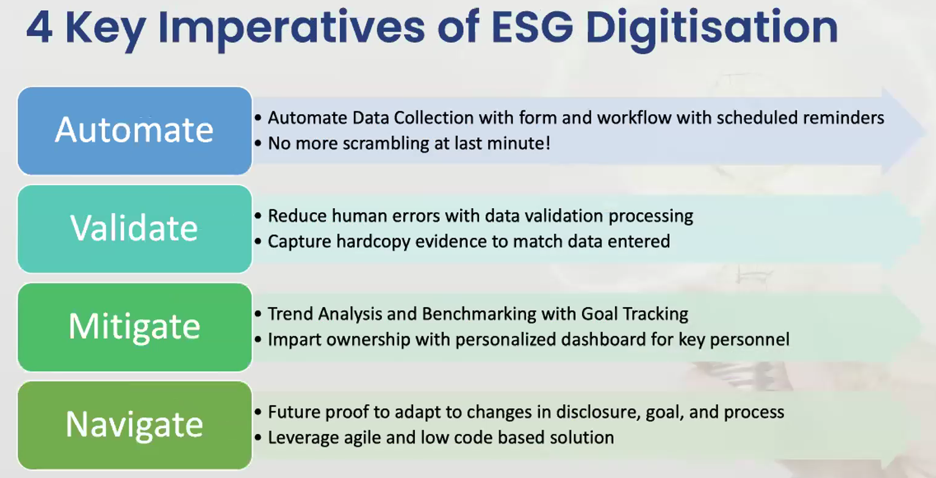The Vital Role of Digitization in Enhancing ESG Reporting
A Path to Transparency and Efficiency
8/1/20235 min read


In today’s business environment, integrating Environmental, Social, and Governance (ESG) considerations into corporate strategy is not often just a regulatory requirement but also a competitive necessity. The Boston Consulting Group shared,
“Strong performance with regard to ESG factors can unlock significant positive impact for investors, companies, and society. Similarly, integrating forward-looking ESG considerations into strategy and practice can lead to long-term corporate resilience and improved allocation of capital”.
However the idea of collecting and analyzing data can feel very overwhelming. ESG data management software can simplify the process, ensuring accurate and timely disclosures. However, with a plethora of options available, choosing the right ESG reporting software for your organization can be daunting. After “How do we even start?” “What software should we choose?” is the most frequent question leaders ask me. There are so many variables to look at and these variables lead to more questions so I thought this guide may be helpful when you’re beginning your journey.
Similar to the financial reporting process, ESG disclosures entail both quantitative and qualitative data. New standards and guidelines like the ones from CSRD and IASB urge companies to account for ESG items and issues in their financial performance.
The evolution of sustainability data requirements, however, drives organizations to face an ongoing turnaround in data management. This demands large-scale shifts in business operations and a clear ESG strategy. But luckily, these are complications made significantly easier by technological solutions.
Why Digitize?
The number of regulations and requirements around ESG reporting continues to grow and evolve. To stay on top of these complex reporting processes, automated data collection is a must. Manual data collection, which is prone to human error and results in missing or inaccurate information, is a challenge that digital solutions can address. With each passing year, more industries and locations require auditable and accurate data to better gauge their ESG performance.
While the need to digitize isn’t something new for businesses, as most businesses have implemented robust ERP, CRM, HRM and finance systems to easily capture and manage accurate data in real time, leaders need to acknowledge that applying this concept to ESG data demands the same amount of attention and effort.
The Importance of ESG Digitization
The impact of digital technology is completely visible in the entire business landscape. Operational costs and human errors are reduced, as workflows and processes do not have to be done manually. There are also less likely to be data silos as information is already stored on the cloud instead of physical storage devices.
Apart from general business operations, technology is also beneficial for upgrading the ESG process. In ESG digitization, four imperatives should be taken into account:


From managing reams of data to eliminating operational inefficiencies, ESG digitization can help create more decisive actions toward sustainability. If your business is just taking the first step in digitization, one rewarding tactic is adopting enterprise-wide ESG software.
With many robust technological solutions today, organizations should take time to assess the available options and pick the best one that suits their needs.
What is ESG software?
ESG software is a technological solution designed to facilitate, streamline, and enhance the process of collecting, analyzing, and reporting on an organization’s environmental, social, and governance performance metrics. This solution plays a significant role in enhancing data management, serving as a central repository that consolidates information from various sources and locations.
Equipped with tools for performance evaluation and strategic planning, the software plays a pivotal role in building and managing ESG strategies, as well as monitoring ESG performance. Through centralized data management and automated monitoring, companies can easilyy measure their progress against established ESG goals and benchmarks.
In addition, ESG software enables organizations to align with industry standards, comply with regulations, and meet the growing demand for transparent ESG reporting. In essence, it aids businesses to showcase their commitment to sustainable practices, engage stakeholders, and drive positive impact.
The Benefits of Adopting ESG Reporting Software
Capturing and managing ESG data are onerous yet critical parts of sustainability reporting. To save a considerable amount of time and effort in manual data collection, companies invest in sophisticated ESG software. The list below details the advantages of adopting ESG reporting software.
1. Access to real-time ESG performance
One key point to understanding the long-term risks and opportunities is through ESG performance monitoring. Both the company and its investors should be able to access current and accurate ESG information. This tedious task can be made easier with the right ESG software.
Robust platforms can make regular assessment of performance data possible. The best ESG reporting software allows users to set deadlines and send notifications to alert investors automatically. Updates on ESG data and reports can also be done and tracked in real-time, making sustainable portfolio scoring much faster.
2. Reduced reporting timelines
Prior to implementing specific ESG software, it would take several weeks to manually gather the data from multiple systems, analyze it, and generate reports. Today, with the right ESG software, companies can automate data consolidation and reporting generation. Organizations can conveniently access their sustainability portfolio while navigating through different reporting requirements.
To speed up your reporting timeline, opt for ESG reporting software that is purpose-built to comply with major frameworks such as SASB, GRI, TCFD, and CDP. It should also let you review actionable insights from peers and automate scenario analysis.
3. Encourage investment and employee retention
At COP26, a call for heightened climate pledges has been highlighted. Campaign demands and substantial investments like impactful mitigation are deemed essential. Also, innovative commitments such as decreasing the use of plastic in the supply chain and transitioning to green energy are brought up.
With over $51.1 billion of contributed sustainable funds in 2023, it’s profitable for companies to set ESG priorities to attract such investing interest. Doing so is not just appealing to investors but also a deciding factor for employees.
Sustainability is one of the top values many modern employees place high importance on. If they feel like they’re contributing to something bigger, they are more likely to be loyal and enthusiastic about the company they work for.
4. Better compliance and environmental response
Remember that the primary purpose of ESG reporting is to encourage and evaluate sustainable actions and practices among industries. However, manual processes not only impede progress but also exacerbate the global environmental crisis.
Adopting well-designed ESG software can cut off risks of human error and waste management. These platforms often feature customizable templates, whether for generating air emission reports or obtaining ISO 14001 certification.
Notably, they can seamlessly calibrate report structures in adherence to global standards and frameworks. This not only facilitates smoother reporting but also empowers the organization to craft insightful ESG policies and practices.
5. Compare ESG performance with industry averages
ESG reporting software allows companies to compare their sustainability performance with industry averages. This bench-marking offers valuable insights into how your company stacks up against others in your industry. Such platforms often integrate data from external sources, allowing you to assess your ESG efforts against broader industry trends.
For instance, you can analyze your carbon emissions reduction in comparison to the industry average. This way, you can identify areas where you excel and opportunities for improvement.
6. Enhanced data security
Data security is paramount, especially when dealing with sensitive ESG information. Adopting robust ESG reporting software comes with the perk of enhanced data security. It offers strong security measures to safeguard ESG data, which include data encryption, access controls, and regular audits.
Robust data security measures prevent unauthorized access, data breaches, and potential reputation damage. This not only ensures compliance with data protection regulations but also fosters trust among stakeholders — from investors to customers.
This is one area that I always advise clients to work with experienced professionals. There are many good software options out there. However, its paramount to understand which is best for your organization and there are many variables that contribute to that. You wouldn't choose ERP or financial management software without the support
Let's connect!
917.231.0337
info@IgniteGlobalConsulting.com


Ignite Global Consulting
